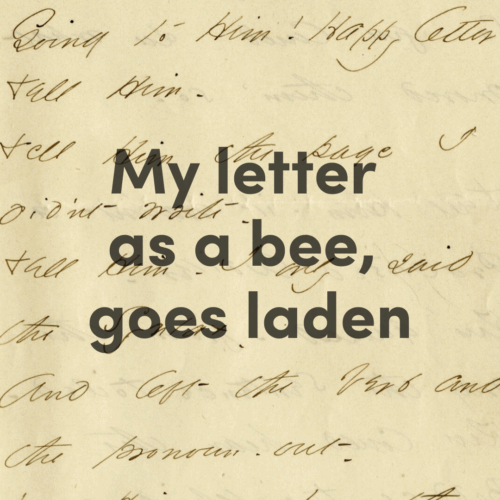“My letter as a bee, goes laden“:
VIRTUAL PROGRAM
Join us for a virtual professional development program for educators exploring Dickinson’s manuscripts. This participatory zoom workshop will provide context and exercises that illuminate Dickinson’s frequently cryptic poetry. Attendees will leave this 90-minute session with new teaching strategies.
Registration is required and is offered on a sliding scale from $5 – $20. Please select the ticket price that is right for you and consider supporting the Museum and the participation of other educators through your purchase. Tickets are non-refundable.
You may request a Professional Development certificate upon registration.
View the full educator workshop lineup.
For any questions, please e-mail edmprograms@emilydickinsonmuseum.org

Join Cristanne Miller, co-editor of The Letters of Emily Dickinson (2022), for a presentation and workshop on teaching with the poet’s letters. Over 1,000 of Dickinson’s letters have been collected–the earliest sent to her brother Austin at the age of 11 and the last written shortly before her death. This new definitive edition–the first in over 60 years–includes almost 300 previously uncollected letters and more than 200 “letter poems.” Each is newly transcribed, revealing some previous transcription errors and uncovering deliberately omitted material.
The resulting collection paints a portrait of Dickinson as witty, engaging, and deeply connected with her community as well as the literature and events of her day. The letters provide meaningful context to her poems and can also stand alone as rich primary sources. This workshop will begin with an overview of the letters and Q&A with Miller, followed by interactive activities and discussion of select letters with Museum staff.
Cristanne Miller is SUNY Distinguished Professor and Edward H. Butler Professor of Literature at University of Buffalo, emerita, where she publishes on nineteenth- and twentieth-century poetry and culture, including Emily Dickinson: A Poet’s Grammar (Harvard University Press, 1987), Reading in Time: Emily DIckinson in the Nineteenth Century (Harvard University Press, 2012), an edition of Dickinson’s complete poems: Emily Dickinson’s Poems: As She Preserved Them (Harvard University Press, 2016), winner of the MLA Scholarly Edition Prize and translated into Portuguese; and The Letters of Emily Dickinson, co-edited with Domhnall Mitchell (Harvard University Press, 2024), named as a best 10 Books of the year by PBS News Hour, NPR, and the London Review of Books. Miller co-edited the 2022 Oxford Handbook of Emily Dickinson with Karen Sánchez-Eppler. She serves on the advisory board of the Emily Dickinson Archive, and formerly on the board of the Emily Dickinson International Society.
